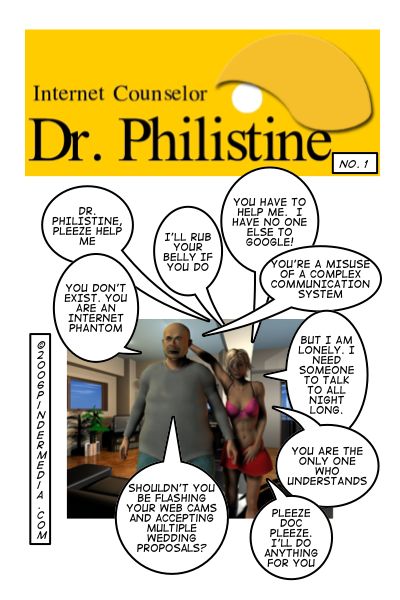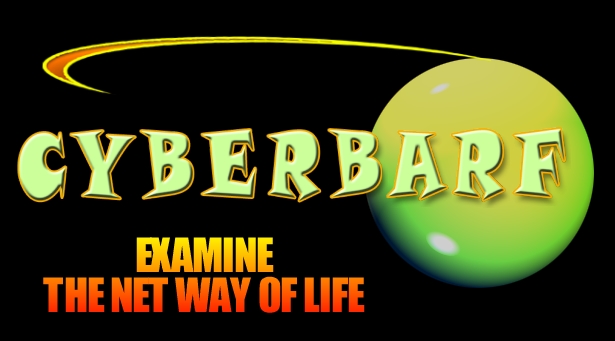It came in the form of a merger of an old sci-fi television
show and a current debate on one of the dangers of the increased dependence
on the internet.
Just because one feels safe inside one's home, in front of
their computer, that does not mean one is safe from themselves. More and more
people are immersing themselves into the Internet world. Some come home from
work and play on-line games to dawn. Others come home to seek companionship
in net chat rooms. Others randomly surf from site to site, blog to blog, like
a whale swimming a vast ocean to filter plankton. When does one begin to drown
in his or her own surfing?
From a report from Eastern Michigan University Technology
Department:
“The concept of Internet addiction has recently entered
the social problem lexicon. Inordinate amounts of time spent engaging in various
types of Internet activities such as muds, chat rooms, and discussion groups
have been cited as having a negative impact on social relationships, marriages,
school achievement, work performance, health, and other vital life functions
(Young, 1998; King, 1996). Given the prediction that 80 percent of American
households will be connected to the Internet by 2000 (Young, 1998), Internet
addiction is perceived as a possible societal epidemic. To address this increasing
concern, The Center for On-Line Addiction (1998) has classified Internet addiction
into five specific types: Cybersexual Addiction Ð Addictions to adult chat
rooms or cyberporn. Cyber-relationship Addiction Ð On-line friendships made
in chat rooms, MUDS, or newsgroups that replace real-life friends and family.
Net Compulsions Ð Compulsive online gambling, online auction addiction, and
obsessive online trading. Information Overload Ð Compulsive web surfing or
database searches Computer Addiction Ð Obsessive computer game-playing or
to programming aspects of computer science.” The complete report is at
http://www.sociology.org/content/vol005.003/ia.html.
The report further stated that Internet addiction could be
defined as follows: “1. Feeling preoccupied with the Internet (for example,
thinking about previous online activity or anticipating the next online session).
2. Feeling a need to use the Internet with increasing amounts of time in order
to achieve satisfaction. 3. Making repeated unsuccessful attempts to control,
cut back, or stop Internet use. 4. Feeling restless, moody, depressed, or
irritable when attempting to cut down or stop Internet usage. 5. Remaining
online longer than intended. 6. Jeopardizing the loss of a significant personal
relationship, job educational, or career opportunity. 7. Lying to family members,
friends, or a therapist to conceal the extent of their involvement with the
Internet. 8. Using the Internet as a means for escaping from problems (Young,
1998, pp. 4-5). In another online survey conducted by Brenner (1996) of 185
Internet users it was reported that 17 percent may be addicted to the Internet,
which included spending 40 or more hours per week online. The survey indicated
that nearly half of the respondents experienced adverse effects in their work
as a result of online usage. Ten percent reported problems with employment
and school due to online activity.”
Various media reports have confirmed the increasing use of
computers by workers in non-employment areas. One article inferred that an
average worker wastes one and one-half hours per day surfing the Internet
on company time. A Vietnam veteran who worked at an IBM research facility
in East Fishkill, N.Y., claims he was wrongfully terminated by the computer
maker for having an addiction to Internet chat rooms, according to a lawsuit
filed by the worker. The worker claims to have an addiction, like alcoholism,
which would trigger anti-discrimination laws and procedures that would have
protected his job from immediate termination. The company rejected that position
and the case is in litigation.
The question of what is the acceptable boundaries of Internet
use, in the work place and outside it, is a continuing source of debate.
The EMU study above, the debate ends at a fork in the road.
There are two ways of looking at this issue. One, under traditional addiction
norms and abnormalities in personality traits or conditions. Two, under a
broader social behavior change resulting from the emergence of new technology
that may be morphing traditional interpersonal socialization into a virtual
social setting. “Based upon the limited findings within this present
study, we are inclined to conclude that the concept of Internet addiction
should be reexamined within the context of how social factors are interfacing
with Internet utilization, and if this merging of man and machine can be researched
or labeled in purely traditional ways.”
From a Virginia Tech research paper, http://www.chem.vt.edu/chem-dept/dessy/honors/papers/ferris.html
DEFINING INTERNET ADDICTION DISORDER, to be diagnosed as having Internet Addiction
Disorder, a person must meet certain criteria as prescribed by the American
Psychiatric Association. Three or more of these criteria must be present at
any time during a twelve month period:
1. Tolerance: This refers to the need for increasing amounts
of time on the Internet to achieve satisfaction and/or significantly diminished
effect with continued use of the same amount of time on the Internet.
2. Two or more withdrawal symptoms developing within days
to one month after reduction of Internet use or cessation of Internet use
(i.e., quitting cold turkey) , and these must cause distress or impair social,
personal or occupational functioning. These include: psychomotor agitation,
i.e. trembling, tremors; anxiety; obsessive thinking about what is happening
on the Internet; fantasies or dreams about the Internet; voluntary or involuntary
typing movements of the fingers.
3. Use of the Internet is engaged in to relieve or avoid
withdrawal symptoms.
4. The Internet is often accessed more often, or for longer
periods of time than was intended.
5. A significant amount of time is spent in activities related
to Internet use ( e.g., Internet books, trying out new World Wide Web browsers,
researching Internet vendors, etc.).
6. Important social, occupational, or recreational activities
are given up or reduced because of Internet use.
7. The individual risks the loss of a significant relationship,
job, educational or career opportunity because of excessive use of the Internet.
In recent research, other characteristics have been identified.
“The first is feelings of restlessness or irritability
when attempting to cut down or stop Internet use. The second is that the Internet
is used as a way of escaping problems or relieving feelings of helplessness,
guilt, anxiety or depression. The third characteristic is that the user lies
to family members or friends to conceal the extent of involvement with the
Internet. And, finally, the user returns repeatedly despite excessive fees
(Egger & Rauterberg, 1996). Internet Addiction Disorder (IAD) is characterized
by seven basic diagnostic criteria, among them increasing tolerance of long
online hours, withdrawal, and unsuccessful efforts to control Internet use.
Ferris, Jennifer R. Internet Addiction Disorders: Causes, Symptoms, and Consequences.”
http://www.chem.vt.edu/chem-dept/dessy/honors/papers/ferris.html
Other authors have found commentary on forms of Internet
addiction. Some believe that Internet addiction is a correctable, benign condition,
and “compensate[s] for a lack of satisfaction in other areas of life.”
Hall, Alex S., and Jeffrey Parsons. "Internet Addiction: College Student Case
Study Using Best Practices in Cognitive Behavior Therapy." Journal of Mental
Health Counseling, 23.4 (October 2001): 312-327.
Some mental health professionals recognize Internet addiction
as a disorder, and are treating it as “a dependency that can be as destructive
as alcoholism and drug addiction.” Kershaw, S. "Hooked on the Web: Help
Is on the Way." The New York Times (December 1, 2005):
Internet addiction can have a devastating impact on peoples'
lives. The Center for On-line Addiction (COLA), which offers intervention
counseling, consulting and training to help conquer this often unrecognized
disorder. COLA was founded by Dr. Kimberly S. Young, Clinical Psychologist
and Assistant Professor of Psychology at the University of Pittsburgh at Bradford.
Resources at the site include online counseling, articles, FAQs, and self-help
tests. Center for On-line Addiction (COLA) http://www.netaddiction.com.
The answer to the question is an interpersonal examination
of how one is using the Internet or how the Internet is controlling them.
The image that came to mind was the fusion of the flaying
robot from Lost in Space screaming, “Danger Free Will, Robinson!
Danger Free Will, Robinson!” behind a tired space boy staring at his
computer screen.
Inspired by the souls being lost in the sink holes of cyberspace,
comic commentary cyberbarf style.
PREMIERE OF A NEW REAL NEWS KOMIX:









